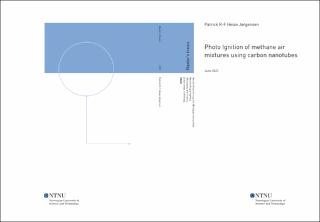| dc.contributor.advisor | Løvås, Therese | |
| dc.contributor.advisor | Embserson, David | |
| dc.contributor.advisor | Bjørgen, Karl Oskar | |
| dc.contributor.author | Jørgensen, Patrick Ruvedel-Flor Heian | |
| dc.date.accessioned | 2022-09-09T17:19:44Z | |
| dc.date.available | 2022-09-09T17:19:44Z | |
| dc.date.issued | 2022 | |
| dc.identifier | no.ntnu:inspera:110277843:67593851 | |
| dc.identifier.uri | https://hdl.handle.net/11250/3016981 | |
| dc.description.abstract | Det er bred enighet om at fossile brennstoff m˚a utveksles med karbonfrie alternativer
grunnet konsekvensene av klima endringer. Ammoniak er sp˚add til ˚a være et
lovende karbon fritt alternativ for maritime fartøy, men forbrennings egenskapene
til ammoniak gjør det til et ikke ideelt drivstoff. En mulighet for ˚a forbedre forbrennings
karakteristikken til amoniakk kan være ˚a se p˚a antenningsmetoden. Et
interessant konsept, først gjennomført av Ajayan et al. [1] viste at ‘’carbon nanotubes”
med metalliske urenheter tar fyr etter de har blitt utsatt for en kamera
blitz. Berkwotz et al. [2] tok dette videre ved ˚a spre disse partiklene homogent
i et forbrennings kammer og oppn˚adde quasi homogen antenning som resulterte i
en kraftigere forbrenning. Det er fremdeles en lang vei ˚a g˚a før denne metoden er
gjennomførbar i en motor sylinder, diskuterbart vil det˚a oppn˚a dette fra en ekstern
kilde være noe av det viktigste.
I denne oppgaven ble gjennomførbarheten av konstant volum forbrenning med fotoindusert
antenning av ‘’carbon nanotubes”, aktivert med en ekstern kilde undersøkt.
M˚alet var ˚a analysere ulike strategier for ˚a eksternt aktivere en forbrenningsprosess
av en metan/luft blanding. Før foto-indusert antenning ble gjennomført, s˚a var
forbrennings kammeret verifisert i form av p˚alitelighet og korrekt blandingsforhold.
Dette ble gjort via data analyse og høy hastighets bilder. Foto-indusert antenning
p˚a ulike partikkel distribusjoner ble sett p˚a, hvor suksessfull antenning skjedde ved
en spredt distribusjon rett foran xenon lampen. Antenningen var begrenset innenfor
et lite intervall av ekvivalens ratioen fra 0.7 til 0.8 ved trykk mellom 2 og 4 bar.
Tre ulike mengder med nanopartikler ble undersøkt, der samtlige antente blandingen
innenfor de nevnte intervallene. Flammen skapt av denne antenningsmetoden
ble filmet ved ekvivalens ratio p˚a 0.8 og trykk ved 4 bar. Flammen var dominert
av effektene skapt av de brennene partiklene og var helt forskjellig fra tennplugg
antenning. Observasjonene gjort foresl˚ar at det finnes en øvre og en nedre grense
for partikkel tettheten, der suksessfull antenning kan skje. For tett og partiklene vil
konsumere det lokale oksygeninnholdet og skape relative store mengder røyk rundt
flammen. For lite og partiklene frigjør ikke nok energi til ˚a aktivere forbrenningen. | |
| dc.description.abstract | The fuel transition from burning hydrocarbons has become an inevitable reality as
the consequences of climate change are evident. Ammonia is forecast to be a major
carbon-free fuel in the emission intensive maritime shipping industry, but as a fuel,
ammonia comprises undesirable combustion characteristics. One of the possibility to
improve these characteristics would be to look at the ignition method. An interesting
concept, first demonstrated by Ajayan et al. [1] showed that carbon nanotubes with
metal impurities ignites in air when exposed to a camera flash. Berkowitz et al. [2]
extended this idea to disperse these particles in a stationary combustion chamber
to achieve quasi homogeneous ignition, resulting in an significantly more efficient
combustion. There are still research gaps for implementing this concept in an engine
cylinder, arguably most importantly would be to achieve the ignition from a remote
energy source.
In this thesis the feasibility of constant volume combustion with photo-induced
ignition of carbon nanotubes with a remote xenon based flash was investigated. The
aim was to analyze different strategies to remotely initiate the combustion process on
a methane/air mixture. Before attempting ignition by the xenon flash, the chamber
was verified in terms of reliability and correct mixture compositions through data
analysis and high speed camera images. Photo-induced ignition on different particle
distributions were looked at, where successful ignition of the mixture occurred in a
dispersed sample in front of the xenon flash. Ignition was limited to the narrow range
of the equivalence ratio from 0.7 to 0.8 at initial pressures from 2 to 4 bar. Moreover,
three different amounts of particles were tested and within the aforementioned range
all samples ignited the mixture. The flame was filmed for the equivalence ratio on
0.8 and initial pressure at 4 bar, where the flame was dominated by the effects
of the burning particles. Observations suggested that for photo-induced ignition
on carbon nanotubes, there are an upper and a lower limit for the burning particle
density where successful ignition could occur. It was concluded that too dense would
consume the local oxygen while creating a relatively large amount smoke, and too
spread out would not release enough local heat to initiate the combustion of the
mixture. | |
| dc.language | eng | |
| dc.publisher | NTNU | |
| dc.title | Photo Ignition of methane air mixtures using carbon nanotubes | |
| dc.type | Master thesis | |
